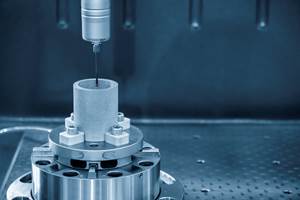A Hollow-Access Unit for Wire EDM
By simultaneously rotating and tilting the workpiece, this rotary tilt/turn hollow-access device from Hirschmann enables the EDM wire to cut complex openings that may have different paths at the top and bottom of the opening.
Share





The “cutting tool” in wire EDM is the energized wire that passes into and through a workpiece as it travels from reel to reel. This is a remarkably flexible and capable cutting process because the path and orientation of the traveling wire is highly maneuverable under the multi-axis command of the CNC program. In addition, workholding systems for wire EDM can greatly enhance this flexibility and capability by adding coordinated positioning of the workpiece.
A prime example of this is the rotary tilt/turn hollow-access device from Hirschmann and marketed by Methods Machine Tools (Sudbury, Massachusetts) for its line of FANUC EDM units such as the RoboCut C600iA. This special tilt/turn table is available in different sizes. The model shown at IMTS and described here is the model JS FJRTH186RF-P-01.
“Rotary tilt/turn hollow-access” is a mouthful, but it is, in fact, a good way to characterize this device, which attaches to the tooling frame within the tank of the wire machine. It has two servo drives that are interfaced to the CNC. In operation, the unit enables the wire to cut complex openings that may have different paths at the top and bottom of the opening. The result is a “hollow” within a workpiece that may have a variably tapered and/or convoluted shape.
This complex hollowing is possible because the unit simultaneously rotates and tilts the workpiece. Unlike a tilting rotary table which typically rests on the surface of the worktable of a machining center, this unit is mounted from the sides and features a through-hole in which the workpiece is clamped. This arrangement enables the underside to remain open to the tank of the wire machine. In essence, the through-hole securely suspends the workpiece so that the travel of the wire is virtually unimpeded above and below for maximum access. The through-hole on this model is 5.86 inches (149 mm) in diameter and can handle a workpiece as heavy as 220 pounds (100 kg).
The three views of a sample workpiece on this page show the complexity of hollow openings that can be produced with this hollow-access device. This workpiece is 2.5 inches in diameter and 2.5 inches tall. Cutting such openings in this manner has advantages. This kind of tilt/turn table enables these complex contours to be machined while keeping the wire vertical. This means higher-tensile-strength wire can be used to obtain higher accuracy. Using higher-tensile-strength wire also makes wire threading more reliable for more efficient production runs. Because the upper and lower heads are always aligned, flushing with the dielectric water is improved, which results in faster cutting speeds and better surface finishes.
Methods Machine Tools pairs this hollow-access unit with the RoboCut C600iA because the size and capability of this wire machine are well-suited to the application. This machine has ample work tank dimensions to accommodate the overall length and width of the unit, which measures 32.17 by 9.25 inches (817 by 234 mm). The 16-inch stroke of the Z axis (wire height) on this machine provides clearance for the full range of the usable tilting capability of the unit as well.
The RoboCut’s FANUC 31iWB control unit has the processing speed and power for the multi-axis simultaneous control required to coordinate the added rotary and tilting axes in the hollow access unit. The nano interpolation capability of the CNC complements the ±5 arcseconds indexing accuracy of the hollow-access unit’s rotary and tilt servodrives. In addition, the highly reliable wire-threading system and precise wire-tension control of the RoboCut 600iA support cutting of complex hollow openings in workpieces made of demanding materials for medical or aerospace.
Related Content
Parts and Programs: Setup for Success
Tips for program and work setups that can simplify adjustments and troubleshooting.
Read MoreThe Future of High Feed Milling in Modern Manufacturing
Achieve higher metal removal rates and enhanced predictability with ISCAR’s advanced high-feed milling tools — optimized for today’s competitive global market.
Read MoreOrthopedic Event Discusses Manufacturing Strategies
At the seminar, representatives from multiple companies discussed strategies for making orthopedic devices accurately and efficiently.
Read MoreLean Approach to Automated Machine Tending Delivers Quicker Paths to Success
Almost any shop can automate at least some of its production, even in low-volume, high-mix applications. The key to getting started is finding the simplest solutions that fit your requirements. It helps to work with an automation partner that understands your needs.
Read MoreRead Next
AMRs Are Moving Into Manufacturing: 4 Considerations for Implementation
AMRs can provide a flexible, easy-to-use automation platform so long as manufacturers choose a suitable task and prepare their facilities.
Read MoreMachine Shop MBA
Making Chips and 91ÊÓƵÍøÕ¾ÎÛ are teaming up for a new podcast series called Machine Shop MBA—designed to help manufacturers measure their success against the industry’s best. Through the lens of the Top Shops benchmarking program, the series explores the KPIs that set high-performing shops apart, from machine utilization and first-pass yield to employee engagement and revenue per employee.
Read More





















